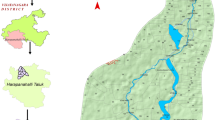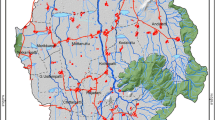Abstract
Soil erosion will have impact in the land productivity, water resource and watershed as a whole. The loss of top soil leads to land degradation and for an agrarian area like Jhimruk which also known as “The rice bowl of Nepal”, it would be a huge consequence on the land productivity. Therefore, it is essential to know the spatial distribution of the areas susceptible to the degradation and assess the erosion potential to plan effective mitigation measures. The Revised Universal Soil Loss Equation (RUSLE) model was used in a Geographic Information System (GIS) to estimate the soil loss of the Jhimruk watershed, Lumbini Province, Nepal. This research aimed to calculate the erosional soil loss status of the local governments lying inside the watershed. For this, remote sensing data obtained from various sources were used to generate the factor maps to calculate the soil loss through RUSLE. A 13-year mean annual precipitation data from the 8 meteorological stations in and around the watershed were used. The mean annual soil loss of the watershed was found to be 13.4 tons per hectare per year (t/ha/yr). However, the soil loss was calculated to be as high as 182 t/ha/yr. 68.82% of the total area of the watershed lie under very low erosion class and thus, have low conservation priority. On the other hand 7.73% of the total area of the watershed lie under extremely high erosion class and, thus, have a high conservation priority class. The mean erosion rate from the barren land was found to be highest (23.179 t/ha/yr) followed by agricultural (21.40 t/ha/yr) and forest area had the lowest erosion rate, i.e., 7.90 t/ha/yr.






Similar content being viewed by others
References
Assouline S, Ben-Hur M (2006) Effects of rainfall intensity and slope gradient on the dynamics of interrill erosion during soil surface sealing. CATENA 66:211–220
Chalise D, Kumar L, Shriwastav CP, Lamichhane S (2018) Spatial assessment of soil erosion in a hilly watershed of Western Nepal. Environ Earth Sci. https://doi.org/10.1007/s12665-018-7842-3
Chen L, Qian X, Shi Y (2011) Critical area identification of potential soil loss in a typical watershed of the three gorges reservoir region. Water Resour Manage 25(13):3445
El-Swaify SA (1997) Factors affecting soil erosion hazards and conservation needs for tropical steeplands. Soil Technol 11(1):3–16
Erencin Z, Shresta DP, Krol IB (2000) C-factor mapping using remote sensing and GIS, Case study Lom SakLom Kao Thail Geogr Inst Justus-Liebig-Univ Giess Intern Inst Aerosp Surv Earth SciITC Enschede Netherland.
Ganasri BP, Ramesh H (2016) Assessment of soil erosion by RUSLE model using remote sensing and GIS—a case study of Nethravathi Basin. Geosci Front 7(6):953–961
Gao GY, Fu BJ, Lü YH, Liu Y, Wang S, Zhou J (2012) Coupling the modified SCS-CN and RUSLE models to simulate hydrological effects of restoring vegetation in the Loess Plateau of China. Hydrol Earth Syst Sci 16(7):2347–2364
Gautam DR (1993) Environmental risk in Nepal: a general assessment. Tribhuvan Univ J 17:87–93
Gautam SK, Sharma D, Tripathi JK, Ahirwar S, Singh SK (2013) A study of the effectiveness of sewage treatment plants in Delhi region. Appl Water Sci 3(1):57–65
Gurung A, Adhikari S, Chauhan R, Thakuri S, Nakarmi S, Ghale S, Dongol BS, Rijal D (2019) Water crises in a water-rich country: case studies from rural watersheds of Nepal’s mid-hills. Water Policy 21(4):826–847
Higaki D, Karki KK, Gautam CS (2005) Soil erosion control measures on degraded sloping lands: a case study in Midlands of Nepal. Aquat Ecosyst Health Manage 8(3):243–249
Jain SK, Kumar S, Varghese J (2001) Estimation of soil erosion for a himalayan watershed using GIS technique. Water Resour Manage 15(1):41–54
Jha M, Paudel R (2010). Erosion predictions by empirical models in a mountainous watershed in Nepal. J Spatial Hydrol 10.
Kaini BR (2018) Losing the land: soil erosion and degradation. The Himalayan Times, Kathmandu
Kalpana B (2006) Application of remote sensing and GIS to soil erosion assessment and spatial risk modeling in Himalayan watershed using hierarchical perspective: a case study in sitla-rao watershed. In 18th World Congress of Soil Science, July 9–15 - Philadelphia, Pennsylvania, USA.
Khalil MI, Fornara DA, Osborne B (2020) Simulation and validation of long-term changes in soil organic carbon under permanent grassland using the DNDC model. Geoderma 361:114014
King C, Baghdadi N, Lecomte V, Cerdan O (2005) The application of remote-sensing data to monitoring and modelling of soil erosion. CATENA 62(2):79–93
Koirala P, Thakuri S, Joshi S, Chauhan R (2019) Estimation of soil erosion in nepal using a RUSLE modeling and geospatial tool. Geosciences (Switzerland) 9(4):1–19
Lal R (2001) Soil degradation by erosion. Land Degrad Dev 12(6):519–539
Men M, Yu Z, Xu H (2008) Study on the spatial pattern of rainfall erosivity based on geostatistics in Hebei Province, China. Front Mech Eng China 2:281–289
Morgan RPC (2005) Soil Erosion and Conservation. Blackwell Publisher, Oxford
Morgan RPC, Morgan DDV, Finney HJ (1984) A predictive model for the assessment of soil erosion risk. J Agric Eng Res 30:245–253
Nearing M, Pruski F, O’Neal MR (2004) Expected climate change impacts on soil erosion rates: a review. J Soil Water Conserv 59:43–50
Pandey A, Mathur A, Mishra SK, Mal BC (2009) Soil erosion modeling of a Himalayan watershed using RS and GIS. Environ Earth Sci 59(2):399–410
Pathak D, Gajurel A, Shrestha G (2008) GIS-based landslide hazard mapping in Jhimruk River Basin, West Nepal. J Nepal Geol Soc 36:25.
Pimentel D (2006) Soil erosion: a food and environmental threat. Environ Dev Sustain 8(1):119–137
Pimentel D, Burgess M (2013) Soil erosion threatens food production. Agriculture 3:443–463
Pimentel D, Kounang N (1998) Ecology of soil erosion in ecosystems. Ecosystems 1(5):416–426
Renard KG, Foster GR, Weesies GA, Porter JP (1991) RUSLE: revised universal soil loss equation. J Soil Water Conserv 46(1):30–33
Rijal M, Pandit HP, Mishra BK (2022) SWAT-based runoff and sediment simulation in a small watershed of Nepalese river: a case study of Jhimruk watershed. Int J Hydrol Sci Technol 13:215–235
Sahu A, Baghel T, Sinha M, Ahmad I, Verma M (2017) Soil erosion modeling using RUSLE and GIS on dudhawa catchment. Int J Appl Environ Sci 12:1147–1158
Sharpley AN, Williams JR (1990) EPIC Erosion/Productivity Impact Calculator: 1. Model Documentation, USA Department of Agriculture Technical Bulletin No. 1768, USA Government Printing Office, Washington DC.
Shin KJ (1999) The soil loss analysis using GIS in watershed, A Master Thesis, Kangwon National University, Gangwon-do, Korea, p. 116.
Shrestha DP, Zinck JA, Van Ranst E (2004) Modelling land degradation in the Nepalese Himalaya. CATENA 57(2):135–156
Shrestha MB, Tamrakar NK, Miyazaki T (2008) Morphometry and sediment dynamics of the churiya river area, siwalik range in Nepal. Boletín De Geología 30:35–48
Sidle RC, Ziegler AD, Negishi JN, Nik AR, Siew R, Turkelboom F (2006) Erosion processes in steep terrain—truths, myths, and uncertainties related to forest management in Southeast Asia. For Ecol Manage 224(1):199–225
Singh P, Gautam S, Singh S, Srivastava P (2016) Appraisal of surface and groundwater of the Subarnarekha River Basin, Jharkhand, India: using remote sensing, irrigation indices and statistical techniques.
Talchabhadel R, Sharma, R (2014) Real time data analysis of west rapti river basin of Nepal. J Geosci Environ Protect 2:1–7
Thapa B, Pant RR, Thakuri S, Pond G (2020) Assessment of spring water quality in Jhimruk River Watershed, Lesser Himalaya, Nepal. Environ Earth Sci. https://doi.org/10.1007/s12665-020-09252-4
Tripathi RP, Ogbazghi W (2016) Watershed management to enhance rainwater conservation and crop yields in semiarid environments—a case study at Hamelmalo Agricultural College, Anseba region of Eritrea. Agric Water Manag 168:1–10
Uddin K, Murthy MSR, Wahid SM, Matin MA (2016) Estimation of soil erosion dynamics in the koshi basin using gis and remote sensing to assess priority areas for conservation. PLoS ONE 11(3):e0150494
USAID (2018) Jhimruk khola watershed profile: status, challenges, and opportunities for improved water resource management. DAI Global LLC, Kathmandu
Williams JR (1975) Sediment-yield prediction with universal equation using runoff energy factor. Present and Prospective Technology for Predicting Sediment Yield and Sources ARS, WA: USDA.
Wischmeir WH, Smith DD (1978). Predicting rainfall erosion losses: a guide to conservation planning (No.537). Science and Education Administration, US Department of Agriculture USDA.
Zhou P, Luukkanen O, Tokola T, Nieminen J (2008) Effect of vegetation cover on soil erosion in a mountainous watershed. CATENA 75:319–325
Acknowledgements
This research was supported by Youth Alliance for Environment (YAE) through USAID PAANI project, which is gratefully acknowledged. We would also like to acknowledge the help and support from Central Department of Environmental Science (CDES) TU, Department of Hydrology and Meteorology, Government of Nepal (for providing the metrological data). We would also like to thank everyone who has been a part of this research.
Author information
Authors and Affiliations
Corresponding author
Ethics declarations
Conflict of interest
None of the author has conflict of issue.
Funding
This study was funded by Youth Alliance for Environment (YAE), Gairidhara, Kathmandu Nepal.
Additional information
Publisher's Note
Springer Nature remains neutral with regard to jurisdictional claims in published maps and institutional affiliations.
Rights and permissions
Springer Nature or its licensor holds exclusive rights to this article under a publishing agreement with the author(s) or other rightsholder(s); author self-archiving of the accepted manuscript version of this article is solely governed by the terms of such publishing agreement and applicable law.
About this article
Cite this article
Pandey, P., Gurung, A. Soil loss and erosion potential estimation of Jhimruk watershed, Nepal. Environ Earth Sci 81, 496 (2022). https://doi.org/10.1007/s12665-022-10602-7
Received:
Accepted:
Published:
DOI: https://doi.org/10.1007/s12665-022-10602-7




